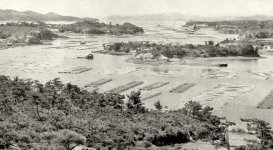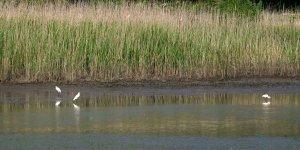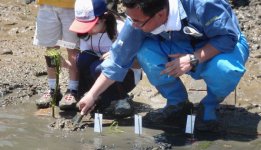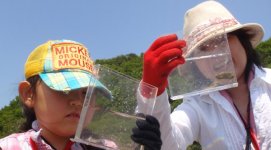Cyril Roger Brossard
Well-known member
- Joined
- Aug 30, 2012
- Messages
- 408
An article by Osamu Matsuda and Hideki Kokubu on July 27, 2012
From north to south, the long coastline of Japan cultivates diverse local lifestyles reflecting unique geographic conditions. People live in harmony with the sea by combining their traditional wisdom with scientific knowledge. These coastal areas, where the sea and human beings are intimately connected, are called ?satoumi?. This article and video brief are part of a series exploring several variations of satoumi, or can be watched as one 74-minute film.
The diverse aquaculture of Japan?s Ago Bay has evolved from a pearl culture tradition seeded more than a century ago. But as the scale of pearl culture and aquaculture has increased, so have negative impacts such as coastal land development.
Faced with ecosystem degradation and ebbing marine resources, the Ago Bay community has embraced a successful satoumi approach to revive scientific understanding of the Bay that promotes economic and ecosystem sustainability (satoumi is defined as marine and coastal landscapes that have been formed and maintained by prolonged interaction between humans and ecosystems).
Ago Bay, located in Mie Prefecture in Central Japan, is a typical enclosed coastal sea with a complex ?ria? coastline of submerged coastal river valleys forming a fingered bay of inlets and islands. The Bay is central to Ise-Shima National Park, which, because of its scenic beauty, valuable natural endowments and long cultural history, was the first national park to be established in Japan.
Historically, the Ago Bay area was known as Miketsu-kuni, a name that reflected its special status as a source of food, particularly marine products, for the Imperial Court and Ise Shrine, one of Japan?s most revered and ancient Shinto shrines. Today, Ago Bay?s calm seascape and rich marine heritage imbues the local community with an innate sense of stewardship rooted in Japan?s traditional satoumi.

Photo courtesy of Sima City
Ago Bay is well known for its pearl culture, a perfect fit for the mild climate and the Bay?s enclosed marine environment that is protected from sea wave disturbance. The Bay naturally provided a healthy habitat for the Akoya oyster. Then in 1893 a local marine products trader, together with fisheries scientists, succeeded in producing the world?s first quality semicircular pearl after inserting a small sphere of shell into an oyster, from which a pearl would form.
Following this technical breakthrough, pearl culture was further developed and prospered in Ago Bay. After World War II, pearl production in Mie Prefecture dominated the Japanese market for ornamental pearls and export for the international market expanded too. Later, benefiting from techniques derived from Akoya pearl culture, local people established other forms of aquaculture including cultivation of aonori, or green laver ( Monostroma sp.). The twentieth century development of pearl and laver culture has become the basis of human interaction with the Bay.
Together, these enterprises contribute to vistas that evoke a quintessential satoumi seascape in the popular imagination. On the calm surface of a small, enclosed sea surrounded by green hills, nets and oyster rafts sway quietly on the water, continuing the age-old, harmonious interplay between ocean and humans. Nets set along the coast for green laver culture can be seen all over the Bay from autumn to spring, reflecting the changing seasons and echoing the transient nature of the seascape.

Photo: Ryo Murakami
Changes to the marine ecosystem
In 1960, Ago Bay?s total catch, including shellfish, sea cucumbers, prawns and seaweed, was over 600 tons. But this figure fell dramatically after 1965, partly because of the deterioration of the Bay environment and the change from traditional fisheries to pearl oyster cultivation.
Subsequently, green laver culture was developed in the late 1960s in response to the decline of pearl oyster culture due to overproduction that caused a rapid increase in the proportion of low quality pearls.
More recently, cultured fisheries have been damaged by eutrophication (an increase in nutrients such as nitrogen and phosphorus that increase algal growth) and red tides. In 1992, a red tide of Heterocapsa circularisquama occurred in Ago Bay for the first time and, since then, there have been frequent harmful blooms of these micro-algae that have caused mass mortality of the pearl oyster.
In the mid-1990s, hypoxia (abnormally low levels of dissolved oxygen) began occurring every year in the deeper layers of central and inner Ago Bay waters, usually from June to October. Seasonally occurring hypoxia has caused a severe decline in the number of shellfish, Polychaeta (bristleworms) and other benthic (bottom/sediment dwelling) organisms that, unlike fish, are unable to move out of hypoxic waters.
During the summer of 2002, large-scale hypoxia enveloped the Ago Bay marine ecosystem and eradicated a large part of its aquatic life, including its inner-bay pearl culture. Because of hypoxia and red tide, much of the marine biological diversity of the Bay was lost, and the aerobic decomposition of organic material was disturbed, disrupting nutrient circulation in the water.
Dramatic physical changes in Ago Bay?s coastal geography have also played a prominent role in transforming the tidal ecosystem. Surveys indicate that since the 1700s, approximately 70 percent of tidal flats and shallow areas have been lost to land development and dyke construction. Establishment of rice fields was followed by construction of concrete protective dykes beginning in the 1940s, which contributed to a rapid decrease of tidal flats from the mid 20th century onwards.

Photo: Ryo Murakami
Macrobenthos ( benthos are organisms found on or near the seabed) on both sides of the dyke became rare, because sediment quality was relatively oligotrophic (nutrient-poor) in front of the dyke (sea side), and it was hypertrophic (nutrient over-enriched) behind the dyke (landward), where little seawater had entered since the dyke was built around 1960. Rainwater and organic matter from the land had accumulated for over 50 years.
This, combined with the rising levels of residential discharge and organic load from pearl culture into the Bay, caused serious deterioration in the benthic ecosystem, resulting in a decrease in biological diversity and productivity in Ago Bay.
Restoring the ecosystem and biodiversity
Responding to the negative ecosystem changes and the effect on local fisheries, fishing communities, scientists and local government officials co-adopted a satoumi approach to restoration. They saw satoumi not simply as focused on restoring a traditional, nostalgic seascape, but also as a practical conservation framework that applies carefully controlled human modification of the environment.
The aim was to recreate a productive, functional and sustainable Ago Bay based on scientific data and community initiative. Called the ?Environmental Restoration Project on Enclosed Coastal Seas in Ago Bay?, the initiative was managed under a regional programme of the Japan Science and Technology Agency.
In 2008, the Committee for the Promotion of Environmental Restoration in Ago Bay was formed to spark collaborations that would enhance biological diversity and biological productivity, including controlling sediment quality, improving seagrass beds and enhancing water circulation in strategic areas.
Part of the restoration programme created six experimental tidal flats, with sediments of different organic content that could be used to investigate sediment conditions suitable for macrobenthos habitat. After three years, an optimal range in sediment parameters for the macrobenthos was found.

Photo: Ryo Murakami
The results showed that the balance of organic matter and mud content in the sediment must be carefully adjusted and maintained to provide a sound habitat for macrobenthos. By utilizing those findings, practical methods were developed to control sediment conditions and enhance biological productivity in two types of shallow areas in Ago Bay.
In the case of the relatively oligotrophic tidal flat in front of the dyke, the sediment is coarse (gravel) and contains low amounts of organic matter because the dyke shuts out the nutrient supply from the land. These sediments were improved by mixing them with organic-rich dredged sediment. It was found that this was effective in bringing sediment parameters within the optimal range for macrobenthos diversity.
In the hypertrophic wetland, landward of a dyke, water exchange with the sea was increased using a pump. Sediment quality and abundance and diversity of species were then continuously monitored. The results showed that sediment was hypertrophic and anaerobic before water exchange and that Chironomidae (a family of Nematoceran fly) were the dominant species at that time, because the wetland was brackish. After water exchange, the macrobenthos changed from brackish type to marine type and the diversity gradually increased.
Building on these results, another artificial tidal flat field experiment was carried out. First, benthic algae began inhabiting the flats and saw the number of macrobenthos increase. These results suggested that the artificially constructed tidal flat ecosystem became a system that could support much higher biological diversity.
From north to south, the long coastline of Japan cultivates diverse local lifestyles reflecting unique geographic conditions. People live in harmony with the sea by combining their traditional wisdom with scientific knowledge. These coastal areas, where the sea and human beings are intimately connected, are called ?satoumi?. This article and video brief are part of a series exploring several variations of satoumi, or can be watched as one 74-minute film.
Faced with ecosystem degradation and ebbing marine resources, the Ago Bay community has embraced a successful satoumi approach to revive scientific understanding of the Bay that promotes economic and ecosystem sustainability (satoumi is defined as marine and coastal landscapes that have been formed and maintained by prolonged interaction between humans and ecosystems).
Ago Bay, located in Mie Prefecture in Central Japan, is a typical enclosed coastal sea with a complex ?ria? coastline of submerged coastal river valleys forming a fingered bay of inlets and islands. The Bay is central to Ise-Shima National Park, which, because of its scenic beauty, valuable natural endowments and long cultural history, was the first national park to be established in Japan.
Historically, the Ago Bay area was known as Miketsu-kuni, a name that reflected its special status as a source of food, particularly marine products, for the Imperial Court and Ise Shrine, one of Japan?s most revered and ancient Shinto shrines. Today, Ago Bay?s calm seascape and rich marine heritage imbues the local community with an innate sense of stewardship rooted in Japan?s traditional satoumi.

Photo courtesy of Sima City
Ago Bay is well known for its pearl culture, a perfect fit for the mild climate and the Bay?s enclosed marine environment that is protected from sea wave disturbance. The Bay naturally provided a healthy habitat for the Akoya oyster. Then in 1893 a local marine products trader, together with fisheries scientists, succeeded in producing the world?s first quality semicircular pearl after inserting a small sphere of shell into an oyster, from which a pearl would form.
Following this technical breakthrough, pearl culture was further developed and prospered in Ago Bay. After World War II, pearl production in Mie Prefecture dominated the Japanese market for ornamental pearls and export for the international market expanded too. Later, benefiting from techniques derived from Akoya pearl culture, local people established other forms of aquaculture including cultivation of aonori, or green laver ( Monostroma sp.). The twentieth century development of pearl and laver culture has become the basis of human interaction with the Bay.
Together, these enterprises contribute to vistas that evoke a quintessential satoumi seascape in the popular imagination. On the calm surface of a small, enclosed sea surrounded by green hills, nets and oyster rafts sway quietly on the water, continuing the age-old, harmonious interplay between ocean and humans. Nets set along the coast for green laver culture can be seen all over the Bay from autumn to spring, reflecting the changing seasons and echoing the transient nature of the seascape.

Photo: Ryo Murakami
Changes to the marine ecosystem
In 1960, Ago Bay?s total catch, including shellfish, sea cucumbers, prawns and seaweed, was over 600 tons. But this figure fell dramatically after 1965, partly because of the deterioration of the Bay environment and the change from traditional fisheries to pearl oyster cultivation.
Subsequently, green laver culture was developed in the late 1960s in response to the decline of pearl oyster culture due to overproduction that caused a rapid increase in the proportion of low quality pearls.
More recently, cultured fisheries have been damaged by eutrophication (an increase in nutrients such as nitrogen and phosphorus that increase algal growth) and red tides. In 1992, a red tide of Heterocapsa circularisquama occurred in Ago Bay for the first time and, since then, there have been frequent harmful blooms of these micro-algae that have caused mass mortality of the pearl oyster.
In the mid-1990s, hypoxia (abnormally low levels of dissolved oxygen) began occurring every year in the deeper layers of central and inner Ago Bay waters, usually from June to October. Seasonally occurring hypoxia has caused a severe decline in the number of shellfish, Polychaeta (bristleworms) and other benthic (bottom/sediment dwelling) organisms that, unlike fish, are unable to move out of hypoxic waters.
During the summer of 2002, large-scale hypoxia enveloped the Ago Bay marine ecosystem and eradicated a large part of its aquatic life, including its inner-bay pearl culture. Because of hypoxia and red tide, much of the marine biological diversity of the Bay was lost, and the aerobic decomposition of organic material was disturbed, disrupting nutrient circulation in the water.
Dramatic physical changes in Ago Bay?s coastal geography have also played a prominent role in transforming the tidal ecosystem. Surveys indicate that since the 1700s, approximately 70 percent of tidal flats and shallow areas have been lost to land development and dyke construction. Establishment of rice fields was followed by construction of concrete protective dykes beginning in the 1940s, which contributed to a rapid decrease of tidal flats from the mid 20th century onwards.

Photo: Ryo Murakami
Macrobenthos ( benthos are organisms found on or near the seabed) on both sides of the dyke became rare, because sediment quality was relatively oligotrophic (nutrient-poor) in front of the dyke (sea side), and it was hypertrophic (nutrient over-enriched) behind the dyke (landward), where little seawater had entered since the dyke was built around 1960. Rainwater and organic matter from the land had accumulated for over 50 years.
This, combined with the rising levels of residential discharge and organic load from pearl culture into the Bay, caused serious deterioration in the benthic ecosystem, resulting in a decrease in biological diversity and productivity in Ago Bay.
Restoring the ecosystem and biodiversity
Responding to the negative ecosystem changes and the effect on local fisheries, fishing communities, scientists and local government officials co-adopted a satoumi approach to restoration. They saw satoumi not simply as focused on restoring a traditional, nostalgic seascape, but also as a practical conservation framework that applies carefully controlled human modification of the environment.
The aim was to recreate a productive, functional and sustainable Ago Bay based on scientific data and community initiative. Called the ?Environmental Restoration Project on Enclosed Coastal Seas in Ago Bay?, the initiative was managed under a regional programme of the Japan Science and Technology Agency.
In 2008, the Committee for the Promotion of Environmental Restoration in Ago Bay was formed to spark collaborations that would enhance biological diversity and biological productivity, including controlling sediment quality, improving seagrass beds and enhancing water circulation in strategic areas.
Part of the restoration programme created six experimental tidal flats, with sediments of different organic content that could be used to investigate sediment conditions suitable for macrobenthos habitat. After three years, an optimal range in sediment parameters for the macrobenthos was found.

Photo: Ryo Murakami
The results showed that the balance of organic matter and mud content in the sediment must be carefully adjusted and maintained to provide a sound habitat for macrobenthos. By utilizing those findings, practical methods were developed to control sediment conditions and enhance biological productivity in two types of shallow areas in Ago Bay.
In the case of the relatively oligotrophic tidal flat in front of the dyke, the sediment is coarse (gravel) and contains low amounts of organic matter because the dyke shuts out the nutrient supply from the land. These sediments were improved by mixing them with organic-rich dredged sediment. It was found that this was effective in bringing sediment parameters within the optimal range for macrobenthos diversity.
In the hypertrophic wetland, landward of a dyke, water exchange with the sea was increased using a pump. Sediment quality and abundance and diversity of species were then continuously monitored. The results showed that sediment was hypertrophic and anaerobic before water exchange and that Chironomidae (a family of Nematoceran fly) were the dominant species at that time, because the wetland was brackish. After water exchange, the macrobenthos changed from brackish type to marine type and the diversity gradually increased.
Building on these results, another artificial tidal flat field experiment was carried out. First, benthic algae began inhabiting the flats and saw the number of macrobenthos increase. These results suggested that the artificially constructed tidal flat ecosystem became a system that could support much higher biological diversity.


